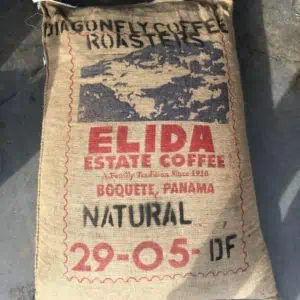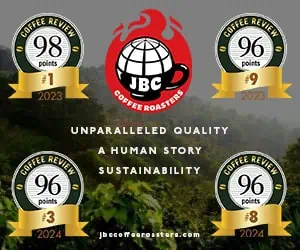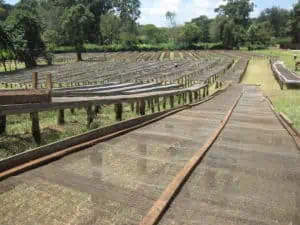This is not your typical Coffee Review tasting report. In fact, it is something of an unplanned improvisation. We originally had scheduled a tasting report on coffees of Costa Rica this month, but we decided to postpone it until next month, October. It turned out that Costa Ricas were slow to arrive in roasters’ warehouses this crop year, and we feared that if we rushed the article we would miss out on some gems and fail to do justice to this classic yet innovating origin.
So I thought I might take this opportunity to write more subjectively and in more depth about a handful of the many extraordinary coffees that we have tested and reviewed over the past three weeks or so. I focus on three of those coffees, but reference several more.
I suppose this report is compensation for the nagging regret we often feel when we send our brief reviews out into the world to represent coffees that constitute so much more than we can convey in our reviews, coffees that are complex, collaborative transoceanic creative acts, acts so rich, singular and radiant in their distinction that they deserve not just a number and a description, but entire essays of the kind our culture devotes to the best films and books and music. Great coffees may resemble one another according to style and type—great Kenyas may resemble other great Kenyas and great Ethiopia naturals more or less resemble other great Ethiopia naturals, for example—but each coffee itself is unique in its detail, and given coffee’s short shelf-life, absolutely singular in time and place. Each one will never, in its entirely and detail, exist in the world again in quite the same way.
I’ll get to the coffees in a moment, but while I’m riding this horse I would add that the finest of the small-lot coffees we review every month are the creation not only of a single producer or group of producers, not only of a single roasting company and single importer, but of an entire coffee culture. Each luminous success we report on is also a tribute to those who design and make happen the growing number of instructional programs for roasters, the green and roasted coffee competitions, the research and support programs for producers, the aficionados who buy, brew and appreciate fine coffees—in essence, the entire expanding human infrastructure that sustains the art of small-lot coffee.
To Celebrate or Mourn?
Mainly I want to praise, honor and give credit to some representative examples of coffee brilliance. But it is a complex and fraught time in the coffee world today. In consuming countries, coffee has never been so hip and trendy, whereas in most producing countries, prices paid for green coffees have seldom in history been so low for so long a time. Compounding that disturbing paradox is the reality of climate change and a related chain of misfortunes and disasters afflicting already undercompensated producers in growing countries: unprecedented high temperatures and chronic droughts in Africa and Brazil, devastating rust disease epidemics in Latin America, unpredictable weather everywhere.
So one doesn’t know whether to celebrate what seem to be ever-intensifying achievements in the art of fine coffee, or mourn the fate of the losers on the producing end of things, those forgotten and left behind who can’t cope and who are suffering or going under entirely. I am not sure whether to ring the bell for a party or toll the bell for a funeral.
But right here, at this moment, it’s party time. I am going to write in particular about three of the transcendent successes of the art of coffee production and roasting that have come to us over the past couple of weeks, including a few words about the farmers and millers who grew them.
All of the coffees I reference here are currently available for sale by their respective roasting companies, by the way, so if readers want to come to their own sensory conclusions about them they will be able to, at least for the next few weeks.
Purity and Power: The Kenyas
Featured: Paradise Coffee Roasters Kenya Gatomboya Peaberry (96)
Kenyas also recently reviewed and high-rated: Bird Rock Coffee Roasters Kenya Thageini (96); Vigilante Kenya Gathiruini (95)
Right now I am drinking the 96-rated Paradise Kenya Gatomboya. The finest coffees of central Kenya are among the most classic of origins, while also among the most striking and original. Their classic poise and intensity is owing in part to consistently high growing elevations and in part to fruit-removal and drying practices (collectively called processing) conducted using the most traditional and meticulous of methods. Like most fine coffees in the world, Kenyas are wet-processed or “washed,” meaning the skin and fruit flesh are removed from the beans immediately after they are harvested and before they are dried. However, at the cooperative mills of central Kenya the removal of the fruit skin and flesh or mucilage is performed by the traditional ferment-and-wash method, not by machines that squeeze and scrub the sticky mucilage from the beans (and often leave a bit behind) as is increasingly the efficiency-driven practice in many other parts of the world. And those cooperative leaders who operate the Kenya mills appear to be masters of the traditional ferment-and-wash procedures, producing a cup that is both transparently clean yet deeply resonant, grand yet balanced in structure, with its sweet-inclining fusion of sweet, tart, bitter and (a hint of) savory tastes, supple mouthfeel, and purity of aroma, flavor and finish that lets notes speak melodically rather than mutter.
All of that makes Kenya classic. The originality, as opposed to the classic completeness and balance, is almost certainly owing to varieties of Arabica long grown in Kenya called SL-28 and SL-34, both derived from a Bourbon variety brought to East Africa in the mid-19th century, and which may have spontaneously crossed with plant material brought from eastern Ethiopia. (All Arabica material originally came from Ethiopia, of course, but took a productive detour through Yemen and from there on to the rest of the world, including the Isle of Bourbon or Reunion, where the great and prolific Bourbon variety originated as a mutant of a Yemen-derived Typica.) The Bourbon influence has always struck me as most influential in the Kenya profile, but at any rate the great Kenyas offer an original and unmistakable aroma/flavor complex that is at the heart of Kenya elegance and appeal.
A great early coffee leader at Starbucks, Mary Townsend, apparently was the first to use the term “black currant” to describe this unique Kenya flavor constellation. The sweet yet tartly dry, slightly savory berry sensation we associate with black currant is a good descriptive starting point for a fine Kenya, but a starting point only. When we cup a great Kenya like those referenced here, the aroma and flavor descriptors simply don’t stop coming. We almost always get sweet-tart fruit notes (black currant, raspberry, pomegranate), rounder notes of chocolate, coconut or vanilla bean, citrus hints (grapefruit zest, bergamot), aromatic wood (usually fresh-cut cedar or a perfumy sandalwood), and flowers, usually not out front, but always hovering, sweet-toned and shifty.
When we finally get down to crafting our reviews we allow ourselves at most five aroma/flavor descriptors. Given we have three cuppers all offering overlapping but subtly different descriptors for the same set of transient molecular stimuli, and given that these associative descriptors issue from open-minded but strong-willed personalities, the final five descriptors that make it into a review of a complex coffee like a Kenya are much more consensus selection than exhaustive catalog, a hopefully evocative collection of associative threads to follow into the heart of a resonant whole.
Gordon Shepherd, the author of the brilliant (and accessible) book Neurogastronomy: How the Brain Creates Flavor and Why It Matters, writes that “smell has the property of being, in general, ‘synthetic,’ that is, a mixture of several smells makes a new unified smell.” Which is to say that, when we enjoy a coffee, all those overlapping descriptors we dig out of our associative memory banks tend to arrive in a singular surge of pleasure, both unified yet complex and deep, as it just did a moment ago when I took another swig of (my slowly cooling) Paradise Kenya Gatomboya.
A Final Note on Kenyas
Many years ago I used to compare fine Kenyas to fine Cabernets. Now those kinds of beverage analogies strike me as unfair to coffee. Maybe a fine Cabernet should be compared to a fine Kenya. Nevertheless, great Kenyas, when taken black and without sugar, have an amazing way with a whole range of foods, and not just breakfast rolls. Try one with lunch. Try one in the afternoon with something savory. And don’t feel you need to stop when the cup cools. The best Kenyas, like the one that powered these last few paragraphs, are so pure and unswerving in their expression that they are often as satisfying at room temperature as when they are hot and freshly brewed, not to mention splendid on ice.
Coffee Credits
A selection of those along the supply chain who helped create the Paradise Coffee Roasters Kenya Gatomboya profiled here:
Miguel Meza, founder and now (after a hiatus) again co-owner of Paradise Coffee.
Charlie Blasky, Roastmaster and Green Buyer at Paradise Coffee, who proposed buying this coffee, and who, along with an entire team of Paradise cuppers, including Miguel Meza, determined its final roast profile.
Menno Simons and Tim Chapdelaine of Trabocca Coffee, who led in selecting this coffee in Kenya, purchasing it at auction, and importing it to North America.
The 600 farmer-members of the Barichu Cooperative Society who grew the fruit that produced this coffee, with particular credit to the operators of the cooperative’s wet mill, Gatomboya Factory, that so meticulously prepared it.
Technical experts at Scots Laboratory, the research laboratory of the British Colonial Agricultural Department that between 1934 and 1939 selected the SL-28 and SL-34 varieties so crucial to the character of today’s great Kenyas.
Lush and Accessible: The Naturals
Featured: Dragonfly Coffee Roasters Elida Natural “Dragonfly Lot” (94)
Another natural also recently reviewed and high-rated: Argyle Coffee Roasters Gebeb Ethiopia Yirgacheffe Natural (94)
Regular readers of Coffee Review are already familiar with the phenomenon of the “new naturals”: high-end coffees that have been dried inside the entire fruit, rather than after the fruit has been removed, as is the case with the Kenyas described above. These “new” naturals, unlike the more traditional and cheaper kind of mass-harvested, mass-dried naturals, are produced from uniformly ripe fruit, and are coaxed and coddled through the drying process so that (at best) the sugars in the drying fruit flesh trapped inside the skin with the bean do not ferment at all, or ferment cleanly and sweetly without having attracted taste-dampening micro-organisms.
No matter how processors manage the drying, however, the beans are enveloped in drying fruit for a long time, encouraging a considerably greater variety of sensory outcomes than invited by the wet process, with its early, decisive removal of fruit flesh and skin. Consequently, naturals almost always display a much greater variety of processing-related expression than do fine wet-processed coffees like the best Kenyas. And when these new naturals work out, as they more and more frequently do, they can be sweet, fruit-saturated, and extraordinarily seductive.
As I write I am drinking the Dragonfly Natural from Elida Estate in Panama (94). The first impression is great sweetness and very subtly fermented fruit notes. Odor molecules released by ripe fruit and by alcohol are apparently very similar. In poorer quality naturals the fermented, alcohol-related character may be quite explicit, and often not particularly attractive, carrying with it suggestions of overripe, almost composting fruit, often turned heavy and bitter by musty or mildewed notes. But here, in the Elida, the fermenty alcohol suggestion is quite subtle and deeply matrixed in ripe fruit. Around the cupping table, we try to find the right word for it. Faint brandy? Too grapey. How about we call it rye whisky, and give the fruit nuance to a separate descriptor—ripe banana, perhaps? In the end we settle on pear cider (the fermented kind), plus ripe banana.

One of eight bags of Elida Estate Natural that Dragonfly Coffee buys every year, produced from the same field and processed by the same method.
But there is more to this coffee than ripe fruit and subtle ferment. Once past the nose and into the cup we read a very explicit sweetness which someone calls golden sugar; we agree. And there is definitely chocolate. We settle on crisp, unsweetened baker’s chocolate, giving the sweetness to the brown sugar and the hint of cider. Finally, this is no simple, lushly sweet coffee either. For the slight but important citrus suggestion we settle on lemon zest— not whole lemon, just the zesty hint. Flowers too—very sweet, full flowers: honeysuckle.
The structure is poised and attractive too, although the finish, characteristic of slightly fermented naturals, is flavor-saturated but a bit too drying on the tongue, so we assign it an 8 rather than a 9.
Although it is clearly the processing method and procedures that gave this coffee its distinctiveness, its underlying liveliness and classic balance doubtlessly reflect the respected though not flashy tree variety that produced it, Catuai, plus the impact of the high growing elevations and cool temperatures in the highlands where Elida Estate coffees are grown, factors that promote a dense, well-developed bean.
Coffee Credits
A selection of those along the supply chain who helped create the Dragonfly Coffee Roasters Elida Natural:
Tamas Christman and Hilary Clark, who founded Dragonfly Roasters in 2011 and who, over the last few years, have established a coffee relationship with Elida Estate that almost perfectly fits expectations around the popular industry terms “direct trade” and “relationship coffee.” Every year Dragonfly buys the same volume of natural-processed coffee from the same grove of trees on the Elida farm, including the splendid 2015-16 crop beans that composed the sample reviewed here.
Tamas Christman, again, who roasted this coffee for Dragonfly and who roasts all of Dragonfly’s coffees.
Wilford Lamastus, leader and longtime owner, with his family, of Elida Estate, the innovating, prize-winning farm in the cool highlands of Volcan Baru that produced this coffee.
The indigenous peoples of the Ngöbe-Buglé culture, who have developed (by all reports) a comfortable symbiotic relationship with coffee farms like Elida, and who provide the essential seasonal labor involved in selectively harvesting and carefully processing coffees like the one profiled here.
Aside: A Ferment-Free Natural
Today we often cup naturals that have no discernible fruit ferment. True, in these coffees the dried-in-the-fruit processing appears to encourage sweetness, but a less sugary or lushly fruit-toned sweetness than in naturals like the Dragonfly Elida Estate. With the recently-reviewed Argyle Coffee Roasters Gebeb Ethiopia Yirgacheffe Natural (94), the sweetness read to us more like the floral sweetness of dark honey, complicated by certain aromatic wood-related notes—sandalwood, myrrh—and a sweet but crisp fruit we called pear. The chocolate seemed even drier and crisper than the chocolate in the Dragonfly Elida Natural, so, rather than baker’s chocolate, we decided to call it roasted cacao nib.
Fruit of the Earth: A Sumatra
Featured: Kéan Coffee Sumatra Tano Batak (95)
Sumatras offer still another sensory world, different from the pure, intense complexity of the great Kenyas or the fruit-toned seduction of the best of the new naturals. If coffee tradition likes to use the word “fruity” or “fruit-forward” to describe dried-in-the-fruit coffees like the Dragonfly Elida described earlier, the word that tradition likes to apply to Sumatras is “earthy.” And I suppose the Kéan Sumatra Tano Batak I am drinking at the moment is earthy—though here the “earth” is a very complex note, simultaneously sweet and humusy and dry and mineral-like. We were reluctant to trot out the word earthy in our review, partly because that term is often used to justify coffees that are essentially musty or mildewed. We settled on “moist, fresh-fallen leaves” for the foresty, slightly minerally earth-related sensation. Like the dominant flavor constellation in Kenyas, it is a layering of notes rather than a single note: complex, unique, and ultimately precious. Resonating behind and around it is the fruit. At least a dozen descriptors rolled out of us for the rounding fruit sensation; co-cupper Jason Sarley and I each supplied one of the two in our published review, though we registered many. From Jason came the ripe watermelon descriptor; from me the blackberry. But if you drink this coffee with us you will feel, whatever you choose to call it, a sweetly pungent fruit resonating around and behind the note we are short-handing as fresh-fallen leaves. Finally, we found a soft, sweet, nut-toned chocolate. You may have to wait for this note, pause while the coffee softens and sweetens on the palate. Finally, farther away still, a floral note, clear in the nose, backgrounded in the cup. We called it jasmine. Our five-descriptor rule didn’t leave a slot for an aromatic wood note; if it had we probably would have chosen oak.
The structure of this Sumatra is sweet-savory and resonantly drying. The acidity is brisk yet juicy with backgrounded fruit nuance; the mouthfeel soft, plush, though not syrupy. The finish is drying, though rich and flavor-saturated, with a quiet, backgrounded sweetness.
As with dried-in-the-fruit or “natural”-processed coffees like the Dragonfly Elida described earlier, Sumatras like this one derive a good part of their distinctive character from refinements in fruit removal and drying. These traditional Sumatras are “wet-hulled” coffees, meaning the fruit removal was performed by a relatively standard ferment-and-wash procedure, but the drying procedure adds an unorthodox, cup-altering wrinkle, involving interrupting the drying to remove the inner parchment skin before finishing the drying. See the text under the heading “Sumatra’s Unique Wet-Hulling Process” in our July 2016 tasting report, “Learning from Sumatras.” The great innovation in Sumatra coffees is the new understanding of this subtly unique processing variation, and the ability of some coffee mills to control it and refine the sensory outcome.

Just-washed parchment coffee in the Lintong region of Sumatra waiting for the local “collector” to pick it up for further processing.
Of course there are other reasons accounting for the character of this Sumatra, as there are with the other coffees described here. With this Sumatra, growing elevations are medium-high rather than very high, as was the case with the Elida and the Kenya described earlier. The bean is a bit softer here, the acidity less intense. The roast is just a touch darker than was the case with the Paradise Kenya and the Dragonfly Elida, emphasizing depth over brightness. Tree varieties that contributed to this sample are mixed and not particularly distinguished, although there may be secrets yet to be documented on tree varieties in the classic growing regions of Sumatra. But the determining factor in this coffee’s character is almost certainly well-executed and -understood nuances in the wet-hulling processing method.
Coffee Credits
A selection of those along the supply chain who helped create the Kéan Coffee Sumatra Tano Batak:
Martin Diedrich. Martin was raised on a coffee farm in Guatemala, where he started roasting coffee at the age of 13 and later created the successful Southern California-based coffeehouse chain Diedrich Coffee, before exiting the corporate coffeehouse world to found the small-scale community-oriented Kéan Coffee with his wife Karen Varese Diedrich in 2005. The Diedrichs named their new coffee business after their son Kéan.
The small-holding farmers in the Dolok Sanggul district of the Lintong growing region south of Lake Toba in North Sumatra Province, Indonesia, who grew, harvested and wet-processed this coffee to around 40% moisture.
Namora Tani, the experienced mill-operator who collected the moist parchment from the local farmers, brought it to her mill, and expertly finished the drying in two stages. The first drying of the wet parchment coffee is about four hours on a concrete patio; the second drying of the now-hulled coffee is longer, during which it is protected by green-house like roofs. Namora Tani is one of the most respected “collectors” or wet-hullers in the Lintong region.
Eko Purnowowidi, who, around 14 years ago when he worked for Volcafe Specialty Coffee, developed relationships with five different collectors to create some of the earliest branded, high-quality wet-hulled Sumatras, including Blue Batak and Lake Tawar. Eko now works with Olam Specialty Coffee through his group, the Klasik Bean Cooperative.
Alan Nietlisbach and Ian Kluse of Olam Specialty Coffee, the exporter/importers who selected and brought this lot to the U.S.













